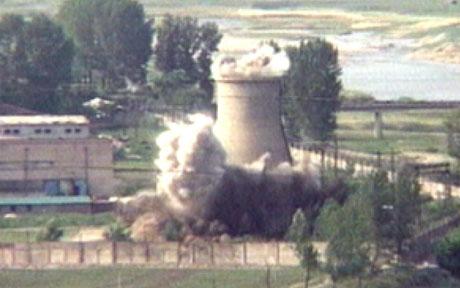And, North Korea has said that they extracted plutonium to be used in nuclear weapons. Maybe around 110 pounds. That doesn't sound like much, but it's enough for 10 nuclear bombs: assuming that each has 5 kilograms of plutonium. That's enough for something shy of the 20 kiloton explosion (like the Trinity test, in 1945): if I did my math right. It's not as powerful as the bomb that devastated Nagasaki, but it's a serious weapon.
There's a diversity of opinion on just what North Korea's media event means, including:
- " 'This is a critical piece of equipment for the nuclear reactor,' said analyst John Wolfsthal, of the Center for Strategic and International Studies, who has been following North Korea since the 1980s. 'Without this facility, the reactor can't operate and can't produce more plutonium for weapons.' "
(CNN) - "The tower is a technically insignificant structure, relatively easy to rebuild. North Korea also has been disabling - though not destroying - more sensitive parts of the nuclear complex, such as the 5-megawatt reactor, a plant that makes its fuel and a laboratory that extracts plutonium from its spent fuel.
" 'It's symbolic. But in real terms, whether demolishing or not a cooling tower that has already been disabled doesn't make much difference,' said Lee Ji-sue, a North Korea expert at Seoul's Myongji University."
(International Herald Tribune)
On the other hand, blowing up that tower has done more good than boost ratings for some news networks.
- Even though it could be re-started easily, that nuclear facility is out of service for now: thanks to a deal between North Korea, America, South Korea, Japan, Russia and China
- After this dramatic show, it's going to be a bit harder for national leaders to ignore a North Korean nuclear program
I think that it's mildly hopeful, and may have positive results, down the road.
In the news:
- "North Korea destroys tower at nuclear plant"
International Herald Tribune (June 27, 2008)- SEOUL, South Korea : With international TV networks filming at the scene, North Korea blew up the most visible symbol of its nuclear program on Friday in a gesture demonstrating its commitment to stop making plutonium for weapons.
- "The 60-foot cooling tower at the North's main nuclear power plant was demolished on Friday, as promised by the North Korean government. The collapse of the concrete structure, the most conspicuous part of the nuclear complex at Yongbyon, 60 miles north of Pyongyang, the North Korean capital, bore witness to the incremental progress that has been made in American-led multilateral efforts to end North Korea's nuclear weapons programs.
- "On Thursday, North Korea submitted its first significant - although partial - account of its arms programs. Almost simultaneously, President Bush announced that Washington was removing North Korea from a U.S. list of state sponsors of terrorism, and issued a proclamation lifting some sanctions under the Trading with the Enemy Act.
- "N. Korea destroys nuclear reactor tower"
CNN (June 27, 2008)- "PYONGYANG, North Korea (CNN) -- North Korea on Friday destroyed a water cooling tower at a facility where officials acknowledge they extracted plutonium to build nuclear weapons, CNN's Chief International Correspondent Christiane Amanpour reported from the scene.
- "The massive implosion, which came at about 5pm local time Friday at the Yongbyon facility, was intended to be a powerful public symbol of a move to end nuclear activities by the Communist nation once branded a member of an "axis of evil" by U.S. President George W. Bush.
- "The destruction of the highly visible symbol of North Korea's long-secret nuclear program came just a day after the country released details of its program.


No comments:
Post a Comment